Holmes Institute: HC1072 Report on Australian Property Market Trends
VerifiedAdded on 2022/12/14
|12
|3191
|154
Report
AI Summary
This report provides a comprehensive overview of the Australian property market, examining its nature, structure, and current market conditions. It analyzes the factors influencing property prices, including the ratio of average housing prices to individual income, foreign investments, and price variations. The report delves into the reasons behind changes in demand, developer interest, and employment, while also exploring the impact of government policies, economic growth, and international investments. The analysis covers the historical trends in housing prices, the role of the Reserve Bank of Australia (RBA), and the influence of international investors, particularly from China. The report concludes by evaluating the market's recent performance and potential future developments, considering the impact of economic factors like unemployment, wage growth, and monetary policy.
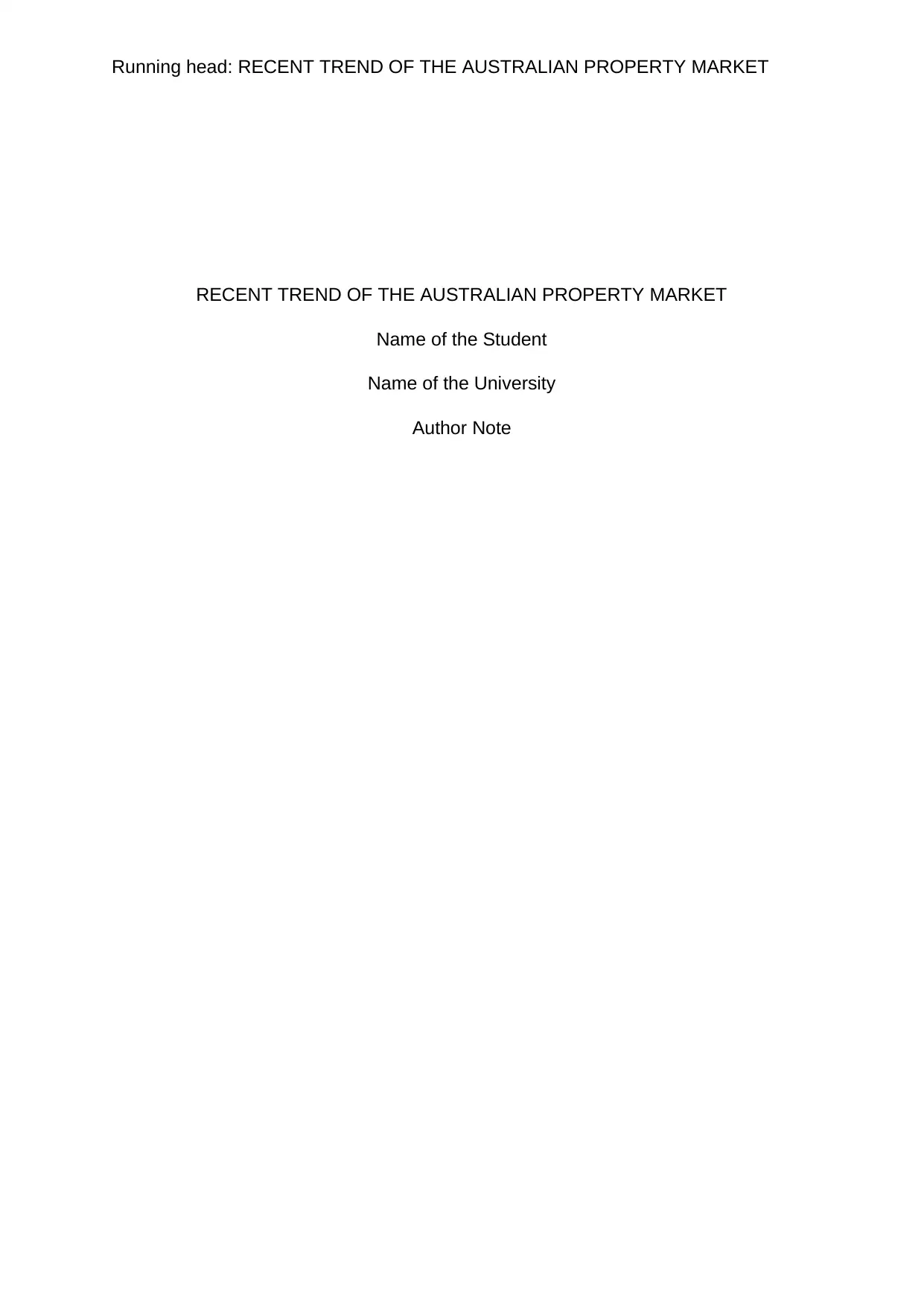
Running head: RECENT TREND OF THE AUSTRALIAN PROPERTY MARKET
RECENT TREND OF THE AUSTRALIAN PROPERTY MARKET
Name of the Student
Name of the University
Author Note
RECENT TREND OF THE AUSTRALIAN PROPERTY MARKET
Name of the Student
Name of the University
Author Note
Paraphrase This Document
Need a fresh take? Get an instant paraphrase of this document with our AI Paraphraser
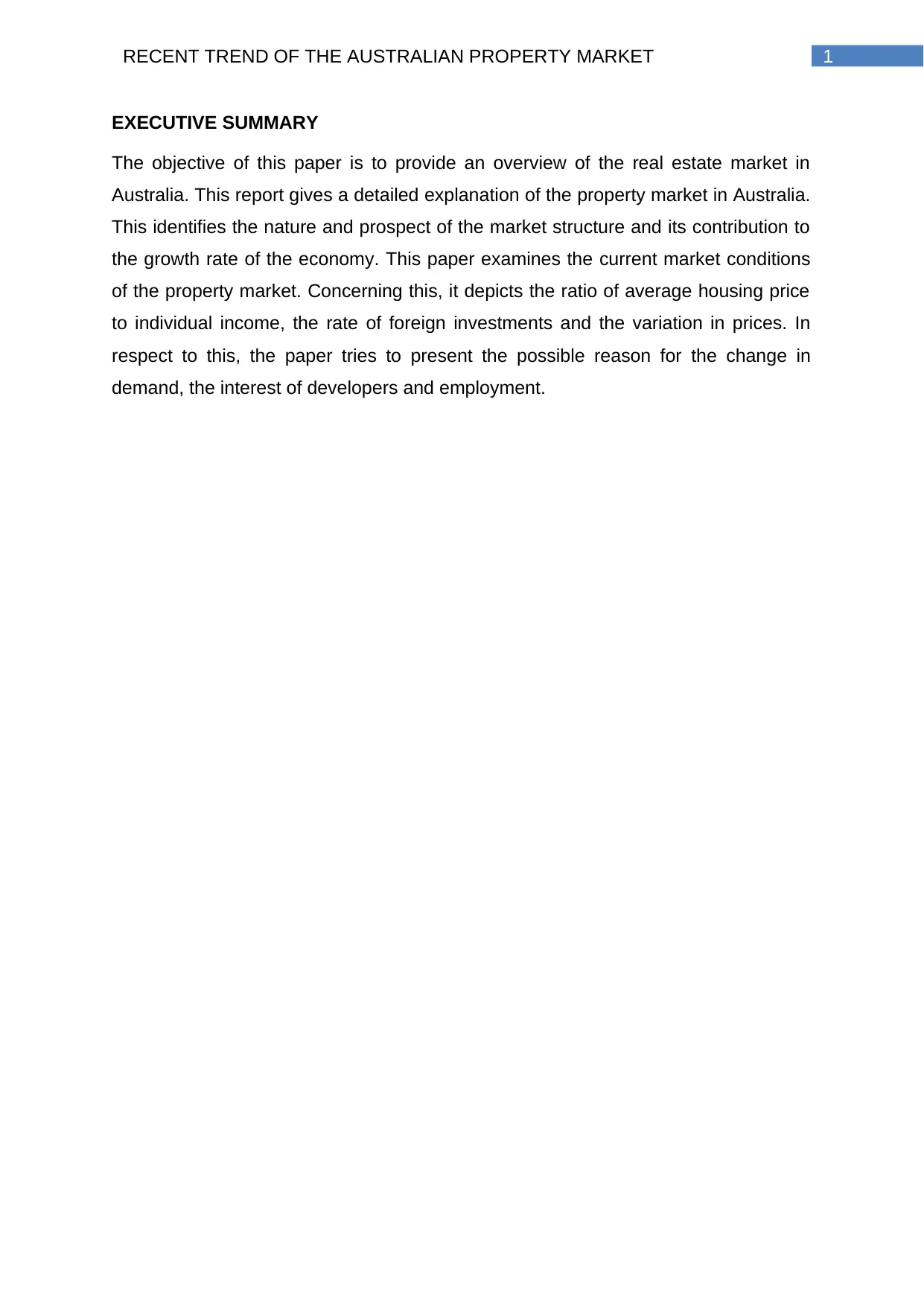
1RECENT TREND OF THE AUSTRALIAN PROPERTY MARKET
EXECUTIVE SUMMARY
The objective of this paper is to provide an overview of the real estate market in
Australia. This report gives a detailed explanation of the property market in Australia.
This identifies the nature and prospect of the market structure and its contribution to
the growth rate of the economy. This paper examines the current market conditions
of the property market. Concerning this, it depicts the ratio of average housing price
to individual income, the rate of foreign investments and the variation in prices. In
respect to this, the paper tries to present the possible reason for the change in
demand, the interest of developers and employment.
EXECUTIVE SUMMARY
The objective of this paper is to provide an overview of the real estate market in
Australia. This report gives a detailed explanation of the property market in Australia.
This identifies the nature and prospect of the market structure and its contribution to
the growth rate of the economy. This paper examines the current market conditions
of the property market. Concerning this, it depicts the ratio of average housing price
to individual income, the rate of foreign investments and the variation in prices. In
respect to this, the paper tries to present the possible reason for the change in
demand, the interest of developers and employment.
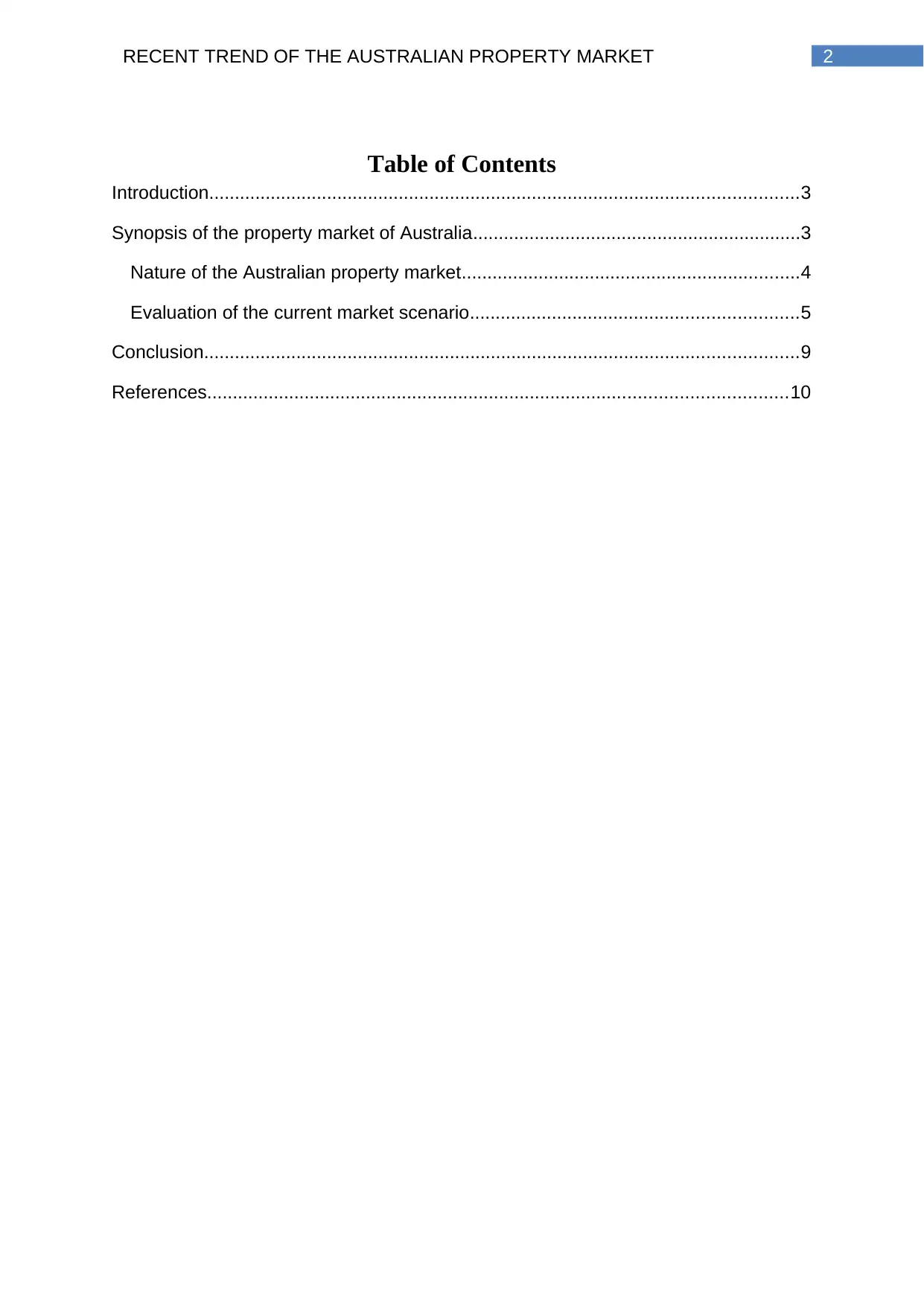
2RECENT TREND OF THE AUSTRALIAN PROPERTY MARKET
Table of Contents
Introduction...................................................................................................................3
Synopsis of the property market of Australia................................................................3
Nature of the Australian property market..................................................................4
Evaluation of the current market scenario................................................................5
Conclusion....................................................................................................................9
References.................................................................................................................10
Table of Contents
Introduction...................................................................................................................3
Synopsis of the property market of Australia................................................................3
Nature of the Australian property market..................................................................4
Evaluation of the current market scenario................................................................5
Conclusion....................................................................................................................9
References.................................................................................................................10
⊘ This is a preview!⊘
Do you want full access?
Subscribe today to unlock all pages.

Trusted by 1+ million students worldwide
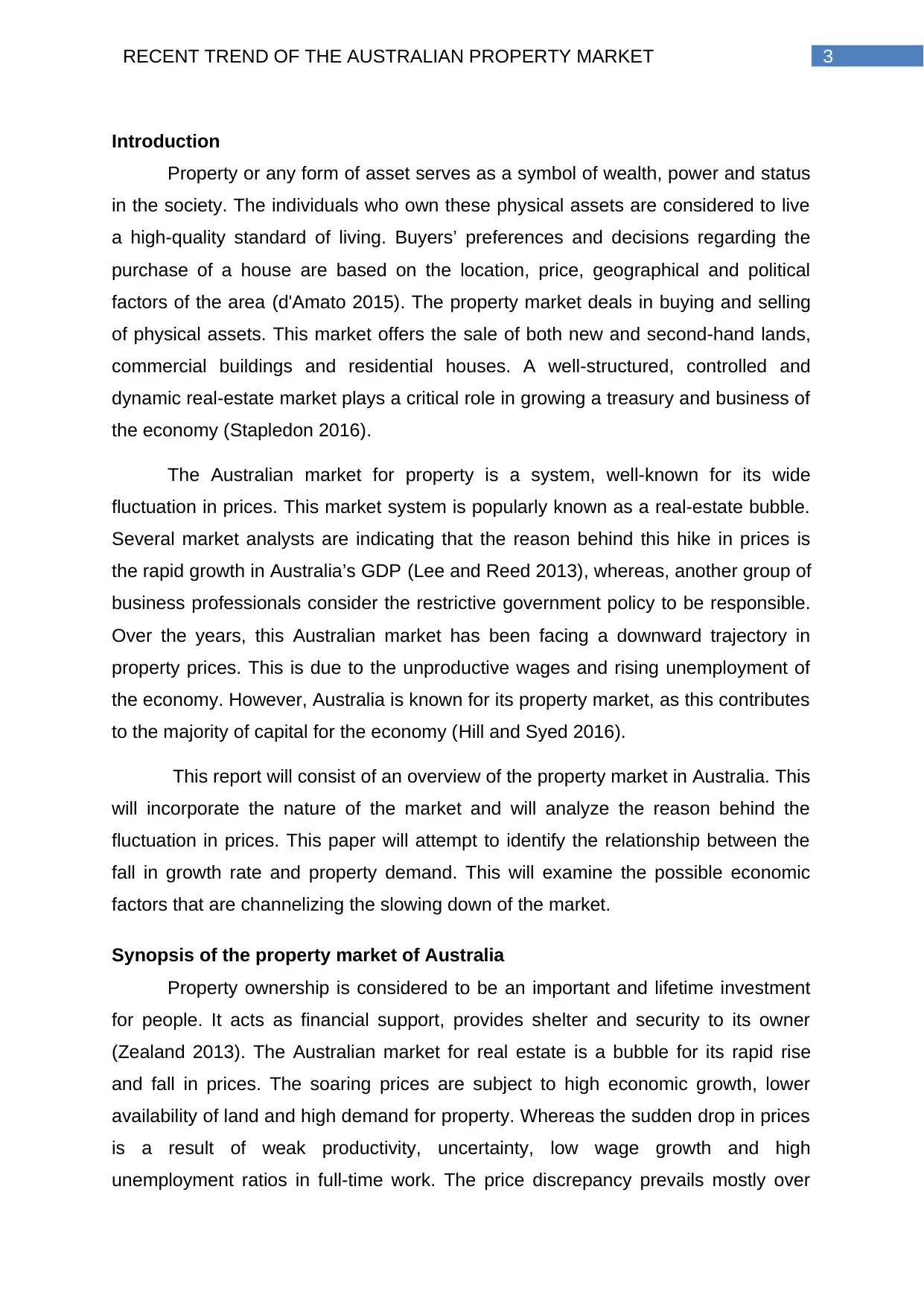
3RECENT TREND OF THE AUSTRALIAN PROPERTY MARKET
Introduction
Property or any form of asset serves as a symbol of wealth, power and status
in the society. The individuals who own these physical assets are considered to live
a high-quality standard of living. Buyers’ preferences and decisions regarding the
purchase of a house are based on the location, price, geographical and political
factors of the area (d'Amato 2015). The property market deals in buying and selling
of physical assets. This market offers the sale of both new and second-hand lands,
commercial buildings and residential houses. A well-structured, controlled and
dynamic real-estate market plays a critical role in growing a treasury and business of
the economy (Stapledon 2016).
The Australian market for property is a system, well-known for its wide
fluctuation in prices. This market system is popularly known as a real-estate bubble.
Several market analysts are indicating that the reason behind this hike in prices is
the rapid growth in Australia’s GDP (Lee and Reed 2013), whereas, another group of
business professionals consider the restrictive government policy to be responsible.
Over the years, this Australian market has been facing a downward trajectory in
property prices. This is due to the unproductive wages and rising unemployment of
the economy. However, Australia is known for its property market, as this contributes
to the majority of capital for the economy (Hill and Syed 2016).
This report will consist of an overview of the property market in Australia. This
will incorporate the nature of the market and will analyze the reason behind the
fluctuation in prices. This paper will attempt to identify the relationship between the
fall in growth rate and property demand. This will examine the possible economic
factors that are channelizing the slowing down of the market.
Synopsis of the property market of Australia
Property ownership is considered to be an important and lifetime investment
for people. It acts as financial support, provides shelter and security to its owner
(Zealand 2013). The Australian market for real estate is a bubble for its rapid rise
and fall in prices. The soaring prices are subject to high economic growth, lower
availability of land and high demand for property. Whereas the sudden drop in prices
is a result of weak productivity, uncertainty, low wage growth and high
unemployment ratios in full-time work. The price discrepancy prevails mostly over
Introduction
Property or any form of asset serves as a symbol of wealth, power and status
in the society. The individuals who own these physical assets are considered to live
a high-quality standard of living. Buyers’ preferences and decisions regarding the
purchase of a house are based on the location, price, geographical and political
factors of the area (d'Amato 2015). The property market deals in buying and selling
of physical assets. This market offers the sale of both new and second-hand lands,
commercial buildings and residential houses. A well-structured, controlled and
dynamic real-estate market plays a critical role in growing a treasury and business of
the economy (Stapledon 2016).
The Australian market for property is a system, well-known for its wide
fluctuation in prices. This market system is popularly known as a real-estate bubble.
Several market analysts are indicating that the reason behind this hike in prices is
the rapid growth in Australia’s GDP (Lee and Reed 2013), whereas, another group of
business professionals consider the restrictive government policy to be responsible.
Over the years, this Australian market has been facing a downward trajectory in
property prices. This is due to the unproductive wages and rising unemployment of
the economy. However, Australia is known for its property market, as this contributes
to the majority of capital for the economy (Hill and Syed 2016).
This report will consist of an overview of the property market in Australia. This
will incorporate the nature of the market and will analyze the reason behind the
fluctuation in prices. This paper will attempt to identify the relationship between the
fall in growth rate and property demand. This will examine the possible economic
factors that are channelizing the slowing down of the market.
Synopsis of the property market of Australia
Property ownership is considered to be an important and lifetime investment
for people. It acts as financial support, provides shelter and security to its owner
(Zealand 2013). The Australian market for real estate is a bubble for its rapid rise
and fall in prices. The soaring prices are subject to high economic growth, lower
availability of land and high demand for property. Whereas the sudden drop in prices
is a result of weak productivity, uncertainty, low wage growth and high
unemployment ratios in full-time work. The price discrepancy prevails mostly over
Paraphrase This Document
Need a fresh take? Get an instant paraphrase of this document with our AI Paraphraser
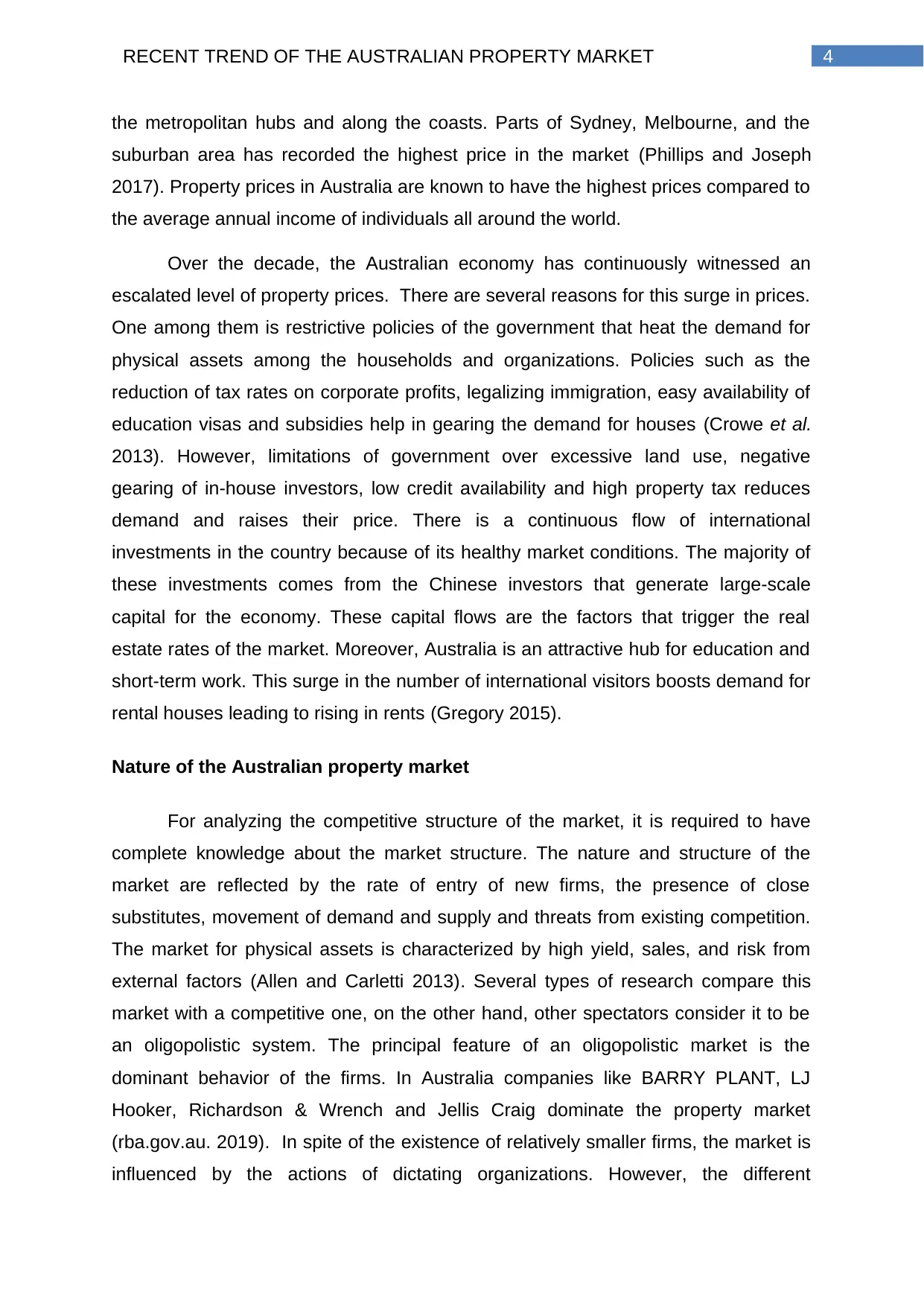
4RECENT TREND OF THE AUSTRALIAN PROPERTY MARKET
the metropolitan hubs and along the coasts. Parts of Sydney, Melbourne, and the
suburban area has recorded the highest price in the market (Phillips and Joseph
2017). Property prices in Australia are known to have the highest prices compared to
the average annual income of individuals all around the world.
Over the decade, the Australian economy has continuously witnessed an
escalated level of property prices. There are several reasons for this surge in prices.
One among them is restrictive policies of the government that heat the demand for
physical assets among the households and organizations. Policies such as the
reduction of tax rates on corporate profits, legalizing immigration, easy availability of
education visas and subsidies help in gearing the demand for houses (Crowe et al.
2013). However, limitations of government over excessive land use, negative
gearing of in-house investors, low credit availability and high property tax reduces
demand and raises their price. There is a continuous flow of international
investments in the country because of its healthy market conditions. The majority of
these investments comes from the Chinese investors that generate large-scale
capital for the economy. These capital flows are the factors that trigger the real
estate rates of the market. Moreover, Australia is an attractive hub for education and
short-term work. This surge in the number of international visitors boosts demand for
rental houses leading to rising in rents (Gregory 2015).
Nature of the Australian property market
For analyzing the competitive structure of the market, it is required to have
complete knowledge about the market structure. The nature and structure of the
market are reflected by the rate of entry of new firms, the presence of close
substitutes, movement of demand and supply and threats from existing competition.
The market for physical assets is characterized by high yield, sales, and risk from
external factors (Allen and Carletti 2013). Several types of research compare this
market with a competitive one, on the other hand, other spectators consider it to be
an oligopolistic system. The principal feature of an oligopolistic market is the
dominant behavior of the firms. In Australia companies like BARRY PLANT, LJ
Hooker, Richardson & Wrench and Jellis Craig dominate the property market
(rba.gov.au. 2019). In spite of the existence of relatively smaller firms, the market is
influenced by the actions of dictating organizations. However, the different
the metropolitan hubs and along the coasts. Parts of Sydney, Melbourne, and the
suburban area has recorded the highest price in the market (Phillips and Joseph
2017). Property prices in Australia are known to have the highest prices compared to
the average annual income of individuals all around the world.
Over the decade, the Australian economy has continuously witnessed an
escalated level of property prices. There are several reasons for this surge in prices.
One among them is restrictive policies of the government that heat the demand for
physical assets among the households and organizations. Policies such as the
reduction of tax rates on corporate profits, legalizing immigration, easy availability of
education visas and subsidies help in gearing the demand for houses (Crowe et al.
2013). However, limitations of government over excessive land use, negative
gearing of in-house investors, low credit availability and high property tax reduces
demand and raises their price. There is a continuous flow of international
investments in the country because of its healthy market conditions. The majority of
these investments comes from the Chinese investors that generate large-scale
capital for the economy. These capital flows are the factors that trigger the real
estate rates of the market. Moreover, Australia is an attractive hub for education and
short-term work. This surge in the number of international visitors boosts demand for
rental houses leading to rising in rents (Gregory 2015).
Nature of the Australian property market
For analyzing the competitive structure of the market, it is required to have
complete knowledge about the market structure. The nature and structure of the
market are reflected by the rate of entry of new firms, the presence of close
substitutes, movement of demand and supply and threats from existing competition.
The market for physical assets is characterized by high yield, sales, and risk from
external factors (Allen and Carletti 2013). Several types of research compare this
market with a competitive one, on the other hand, other spectators consider it to be
an oligopolistic system. The principal feature of an oligopolistic market is the
dominant behavior of the firms. In Australia companies like BARRY PLANT, LJ
Hooker, Richardson & Wrench and Jellis Craig dominate the property market
(rba.gov.au. 2019). In spite of the existence of relatively smaller firms, the market is
influenced by the actions of dictating organizations. However, the different
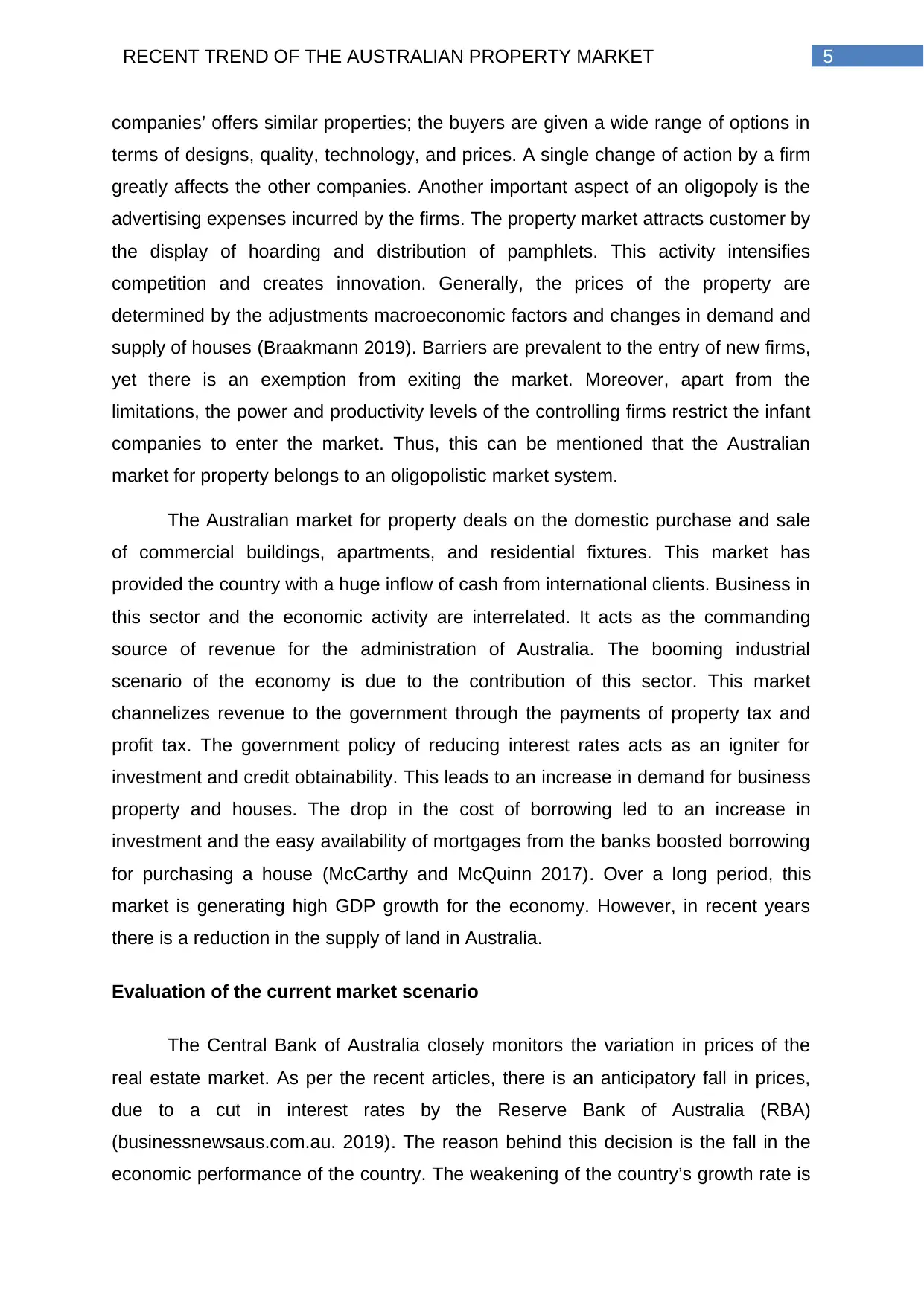
5RECENT TREND OF THE AUSTRALIAN PROPERTY MARKET
companies’ offers similar properties; the buyers are given a wide range of options in
terms of designs, quality, technology, and prices. A single change of action by a firm
greatly affects the other companies. Another important aspect of an oligopoly is the
advertising expenses incurred by the firms. The property market attracts customer by
the display of hoarding and distribution of pamphlets. This activity intensifies
competition and creates innovation. Generally, the prices of the property are
determined by the adjustments macroeconomic factors and changes in demand and
supply of houses (Braakmann 2019). Barriers are prevalent to the entry of new firms,
yet there is an exemption from exiting the market. Moreover, apart from the
limitations, the power and productivity levels of the controlling firms restrict the infant
companies to enter the market. Thus, this can be mentioned that the Australian
market for property belongs to an oligopolistic market system.
The Australian market for property deals on the domestic purchase and sale
of commercial buildings, apartments, and residential fixtures. This market has
provided the country with a huge inflow of cash from international clients. Business in
this sector and the economic activity are interrelated. It acts as the commanding
source of revenue for the administration of Australia. The booming industrial
scenario of the economy is due to the contribution of this sector. This market
channelizes revenue to the government through the payments of property tax and
profit tax. The government policy of reducing interest rates acts as an igniter for
investment and credit obtainability. This leads to an increase in demand for business
property and houses. The drop in the cost of borrowing led to an increase in
investment and the easy availability of mortgages from the banks boosted borrowing
for purchasing a house (McCarthy and McQuinn 2017). Over a long period, this
market is generating high GDP growth for the economy. However, in recent years
there is a reduction in the supply of land in Australia.
Evaluation of the current market scenario
The Central Bank of Australia closely monitors the variation in prices of the
real estate market. As per the recent articles, there is an anticipatory fall in prices,
due to a cut in interest rates by the Reserve Bank of Australia (RBA)
(businessnewsaus.com.au. 2019). The reason behind this decision is the fall in the
economic performance of the country. The weakening of the country’s growth rate is
companies’ offers similar properties; the buyers are given a wide range of options in
terms of designs, quality, technology, and prices. A single change of action by a firm
greatly affects the other companies. Another important aspect of an oligopoly is the
advertising expenses incurred by the firms. The property market attracts customer by
the display of hoarding and distribution of pamphlets. This activity intensifies
competition and creates innovation. Generally, the prices of the property are
determined by the adjustments macroeconomic factors and changes in demand and
supply of houses (Braakmann 2019). Barriers are prevalent to the entry of new firms,
yet there is an exemption from exiting the market. Moreover, apart from the
limitations, the power and productivity levels of the controlling firms restrict the infant
companies to enter the market. Thus, this can be mentioned that the Australian
market for property belongs to an oligopolistic market system.
The Australian market for property deals on the domestic purchase and sale
of commercial buildings, apartments, and residential fixtures. This market has
provided the country with a huge inflow of cash from international clients. Business in
this sector and the economic activity are interrelated. It acts as the commanding
source of revenue for the administration of Australia. The booming industrial
scenario of the economy is due to the contribution of this sector. This market
channelizes revenue to the government through the payments of property tax and
profit tax. The government policy of reducing interest rates acts as an igniter for
investment and credit obtainability. This leads to an increase in demand for business
property and houses. The drop in the cost of borrowing led to an increase in
investment and the easy availability of mortgages from the banks boosted borrowing
for purchasing a house (McCarthy and McQuinn 2017). Over a long period, this
market is generating high GDP growth for the economy. However, in recent years
there is a reduction in the supply of land in Australia.
Evaluation of the current market scenario
The Central Bank of Australia closely monitors the variation in prices of the
real estate market. As per the recent articles, there is an anticipatory fall in prices,
due to a cut in interest rates by the Reserve Bank of Australia (RBA)
(businessnewsaus.com.au. 2019). The reason behind this decision is the fall in the
economic performance of the country. The weakening of the country’s growth rate is
⊘ This is a preview!⊘
Do you want full access?
Subscribe today to unlock all pages.

Trusted by 1+ million students worldwide
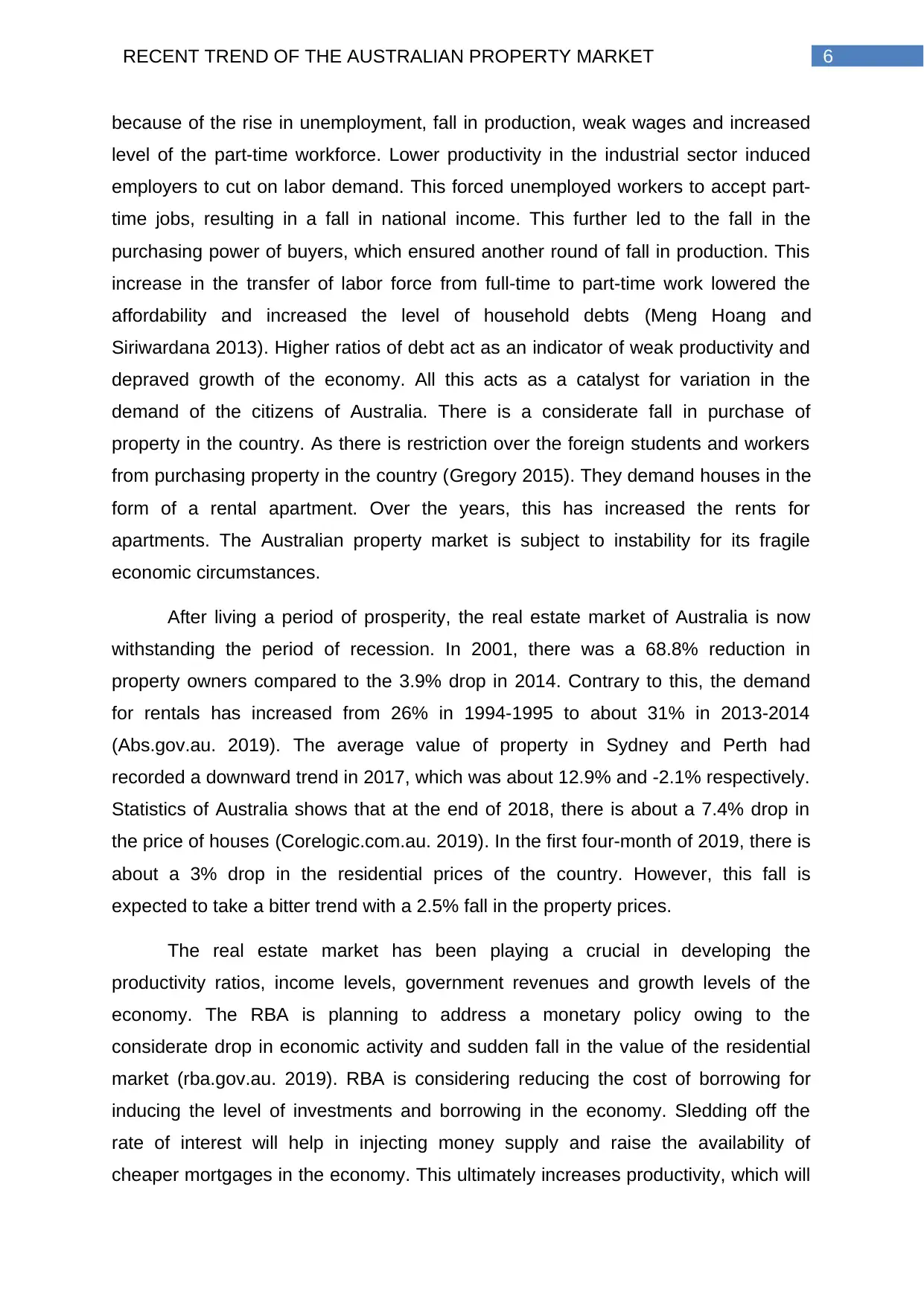
6RECENT TREND OF THE AUSTRALIAN PROPERTY MARKET
because of the rise in unemployment, fall in production, weak wages and increased
level of the part-time workforce. Lower productivity in the industrial sector induced
employers to cut on labor demand. This forced unemployed workers to accept part-
time jobs, resulting in a fall in national income. This further led to the fall in the
purchasing power of buyers, which ensured another round of fall in production. This
increase in the transfer of labor force from full-time to part-time work lowered the
affordability and increased the level of household debts (Meng Hoang and
Siriwardana 2013). Higher ratios of debt act as an indicator of weak productivity and
depraved growth of the economy. All this acts as a catalyst for variation in the
demand of the citizens of Australia. There is a considerate fall in purchase of
property in the country. As there is restriction over the foreign students and workers
from purchasing property in the country (Gregory 2015). They demand houses in the
form of a rental apartment. Over the years, this has increased the rents for
apartments. The Australian property market is subject to instability for its fragile
economic circumstances.
After living a period of prosperity, the real estate market of Australia is now
withstanding the period of recession. In 2001, there was a 68.8% reduction in
property owners compared to the 3.9% drop in 2014. Contrary to this, the demand
for rentals has increased from 26% in 1994-1995 to about 31% in 2013-2014
(Abs.gov.au. 2019). The average value of property in Sydney and Perth had
recorded a downward trend in 2017, which was about 12.9% and -2.1% respectively.
Statistics of Australia shows that at the end of 2018, there is about a 7.4% drop in
the price of houses (Corelogic.com.au. 2019). In the first four-month of 2019, there is
about a 3% drop in the residential prices of the country. However, this fall is
expected to take a bitter trend with a 2.5% fall in the property prices.
The real estate market has been playing a crucial in developing the
productivity ratios, income levels, government revenues and growth levels of the
economy. The RBA is planning to address a monetary policy owing to the
considerate drop in economic activity and sudden fall in the value of the residential
market (rba.gov.au. 2019). RBA is considering reducing the cost of borrowing for
inducing the level of investments and borrowing in the economy. Sledding off the
rate of interest will help in injecting money supply and raise the availability of
cheaper mortgages in the economy. This ultimately increases productivity, which will
because of the rise in unemployment, fall in production, weak wages and increased
level of the part-time workforce. Lower productivity in the industrial sector induced
employers to cut on labor demand. This forced unemployed workers to accept part-
time jobs, resulting in a fall in national income. This further led to the fall in the
purchasing power of buyers, which ensured another round of fall in production. This
increase in the transfer of labor force from full-time to part-time work lowered the
affordability and increased the level of household debts (Meng Hoang and
Siriwardana 2013). Higher ratios of debt act as an indicator of weak productivity and
depraved growth of the economy. All this acts as a catalyst for variation in the
demand of the citizens of Australia. There is a considerate fall in purchase of
property in the country. As there is restriction over the foreign students and workers
from purchasing property in the country (Gregory 2015). They demand houses in the
form of a rental apartment. Over the years, this has increased the rents for
apartments. The Australian property market is subject to instability for its fragile
economic circumstances.
After living a period of prosperity, the real estate market of Australia is now
withstanding the period of recession. In 2001, there was a 68.8% reduction in
property owners compared to the 3.9% drop in 2014. Contrary to this, the demand
for rentals has increased from 26% in 1994-1995 to about 31% in 2013-2014
(Abs.gov.au. 2019). The average value of property in Sydney and Perth had
recorded a downward trend in 2017, which was about 12.9% and -2.1% respectively.
Statistics of Australia shows that at the end of 2018, there is about a 7.4% drop in
the price of houses (Corelogic.com.au. 2019). In the first four-month of 2019, there is
about a 3% drop in the residential prices of the country. However, this fall is
expected to take a bitter trend with a 2.5% fall in the property prices.
The real estate market has been playing a crucial in developing the
productivity ratios, income levels, government revenues and growth levels of the
economy. The RBA is planning to address a monetary policy owing to the
considerate drop in economic activity and sudden fall in the value of the residential
market (rba.gov.au. 2019). RBA is considering reducing the cost of borrowing for
inducing the level of investments and borrowing in the economy. Sledding off the
rate of interest will help in injecting money supply and raise the availability of
cheaper mortgages in the economy. This ultimately increases productivity, which will
Paraphrase This Document
Need a fresh take? Get an instant paraphrase of this document with our AI Paraphraser
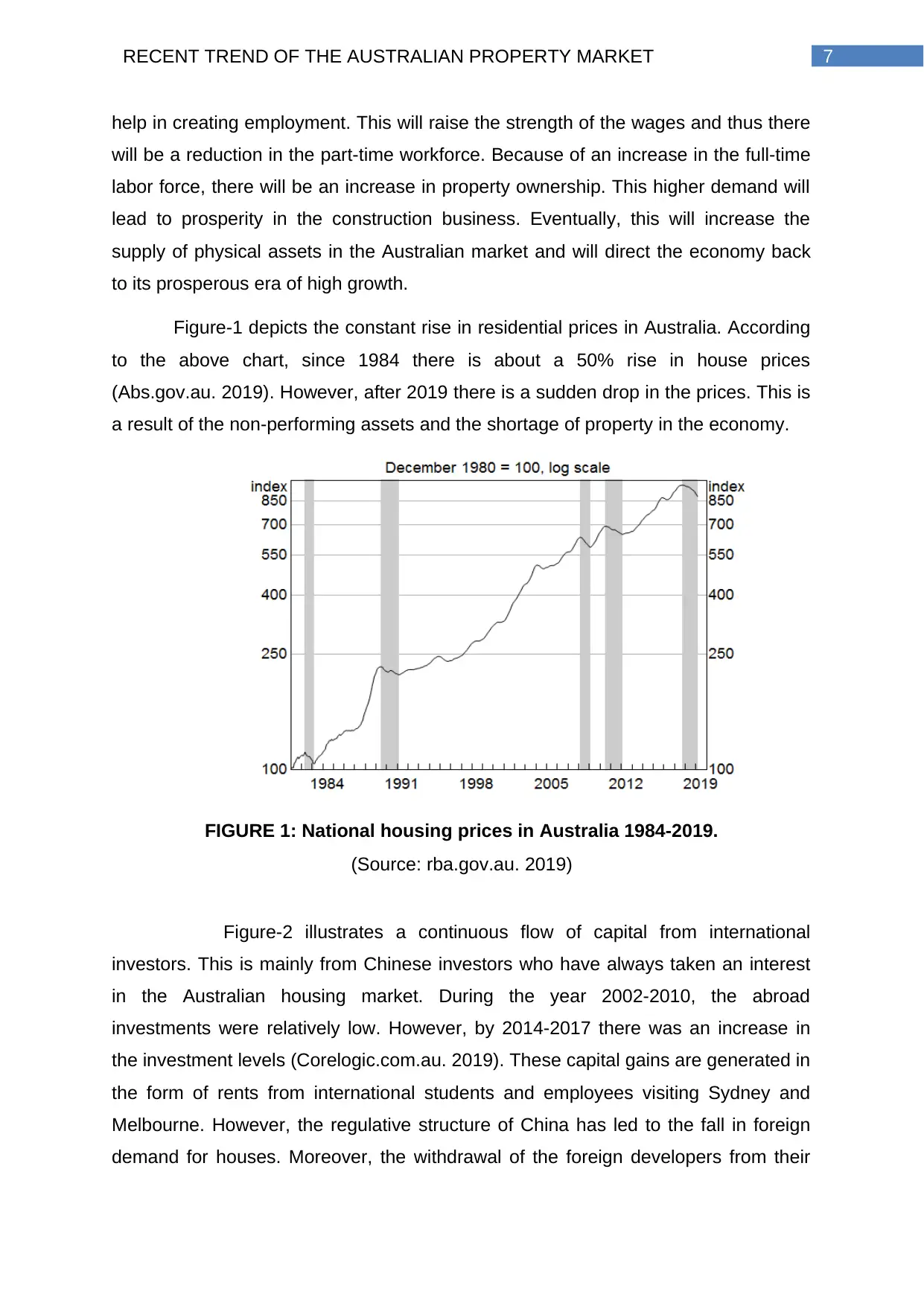
7RECENT TREND OF THE AUSTRALIAN PROPERTY MARKET
help in creating employment. This will raise the strength of the wages and thus there
will be a reduction in the part-time workforce. Because of an increase in the full-time
labor force, there will be an increase in property ownership. This higher demand will
lead to prosperity in the construction business. Eventually, this will increase the
supply of physical assets in the Australian market and will direct the economy back
to its prosperous era of high growth.
Figure-1 depicts the constant rise in residential prices in Australia. According
to the above chart, since 1984 there is about a 50% rise in house prices
(Abs.gov.au. 2019). However, after 2019 there is a sudden drop in the prices. This is
a result of the non-performing assets and the shortage of property in the economy.
FIGURE 1: National housing prices in Australia 1984-2019.
(Source: rba.gov.au. 2019)
Figure-2 illustrates a continuous flow of capital from international
investors. This is mainly from Chinese investors who have always taken an interest
in the Australian housing market. During the year 2002-2010, the abroad
investments were relatively low. However, by 2014-2017 there was an increase in
the investment levels (Corelogic.com.au. 2019). These capital gains are generated in
the form of rents from international students and employees visiting Sydney and
Melbourne. However, the regulative structure of China has led to the fall in foreign
demand for houses. Moreover, the withdrawal of the foreign developers from their
help in creating employment. This will raise the strength of the wages and thus there
will be a reduction in the part-time workforce. Because of an increase in the full-time
labor force, there will be an increase in property ownership. This higher demand will
lead to prosperity in the construction business. Eventually, this will increase the
supply of physical assets in the Australian market and will direct the economy back
to its prosperous era of high growth.
Figure-1 depicts the constant rise in residential prices in Australia. According
to the above chart, since 1984 there is about a 50% rise in house prices
(Abs.gov.au. 2019). However, after 2019 there is a sudden drop in the prices. This is
a result of the non-performing assets and the shortage of property in the economy.
FIGURE 1: National housing prices in Australia 1984-2019.
(Source: rba.gov.au. 2019)
Figure-2 illustrates a continuous flow of capital from international
investors. This is mainly from Chinese investors who have always taken an interest
in the Australian housing market. During the year 2002-2010, the abroad
investments were relatively low. However, by 2014-2017 there was an increase in
the investment levels (Corelogic.com.au. 2019). These capital gains are generated in
the form of rents from international students and employees visiting Sydney and
Melbourne. However, the regulative structure of China has led to the fall in foreign
demand for houses. Moreover, the withdrawal of the foreign developers from their
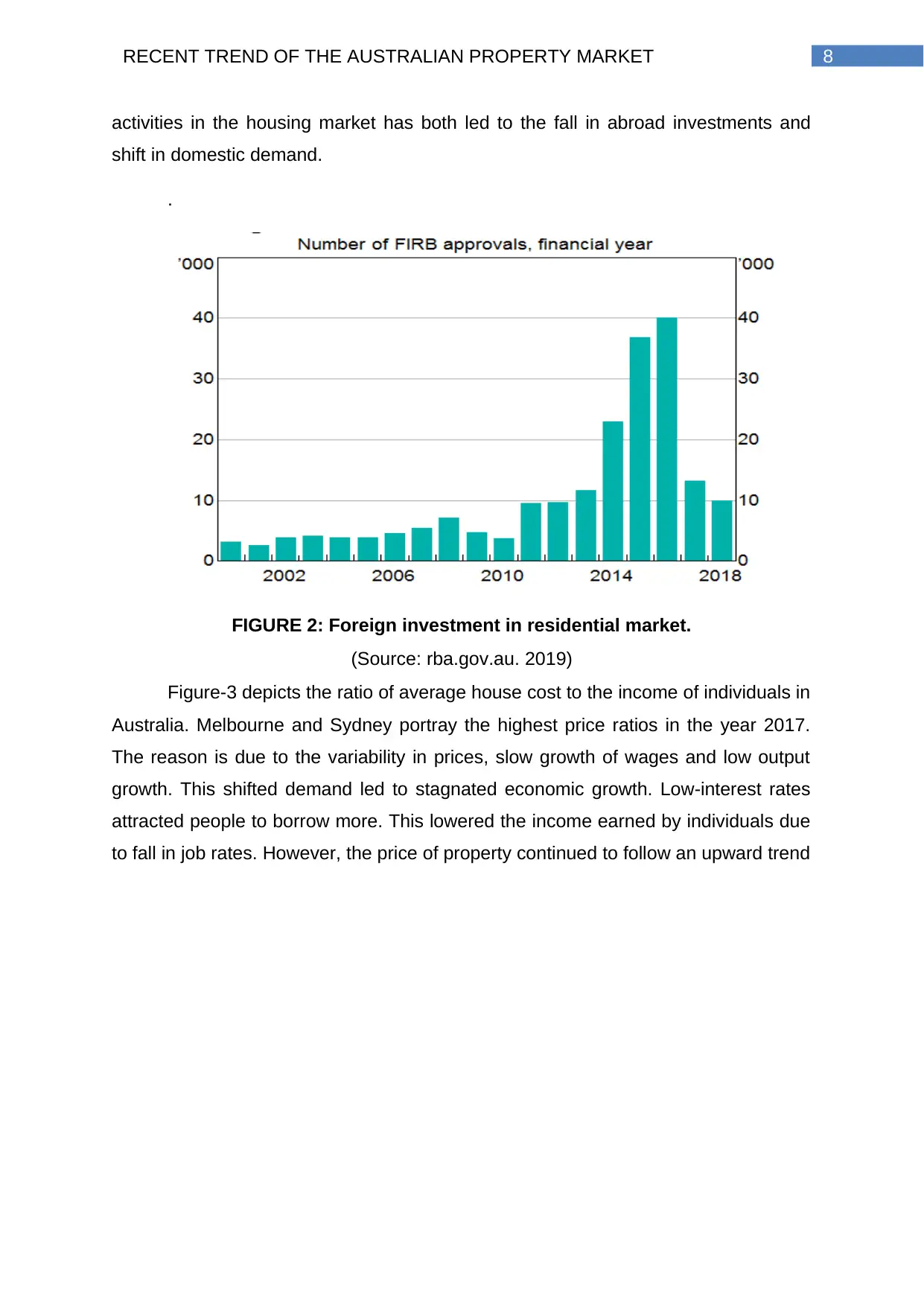
8RECENT TREND OF THE AUSTRALIAN PROPERTY MARKET
activities in the housing market has both led to the fall in abroad investments and
shift in domestic demand.
.
FIGURE 2: Foreign investment in residential market.
(Source: rba.gov.au. 2019)
Figure-3 depicts the ratio of average house cost to the income of individuals in
Australia. Melbourne and Sydney portray the highest price ratios in the year 2017.
The reason is due to the variability in prices, slow growth of wages and low output
growth. This shifted demand led to stagnated economic growth. Low-interest rates
attracted people to borrow more. This lowered the income earned by individuals due
to fall in job rates. However, the price of property continued to follow an upward trend
activities in the housing market has both led to the fall in abroad investments and
shift in domestic demand.
.
FIGURE 2: Foreign investment in residential market.
(Source: rba.gov.au. 2019)
Figure-3 depicts the ratio of average house cost to the income of individuals in
Australia. Melbourne and Sydney portray the highest price ratios in the year 2017.
The reason is due to the variability in prices, slow growth of wages and low output
growth. This shifted demand led to stagnated economic growth. Low-interest rates
attracted people to borrow more. This lowered the income earned by individuals due
to fall in job rates. However, the price of property continued to follow an upward trend
⊘ This is a preview!⊘
Do you want full access?
Subscribe today to unlock all pages.

Trusted by 1+ million students worldwide
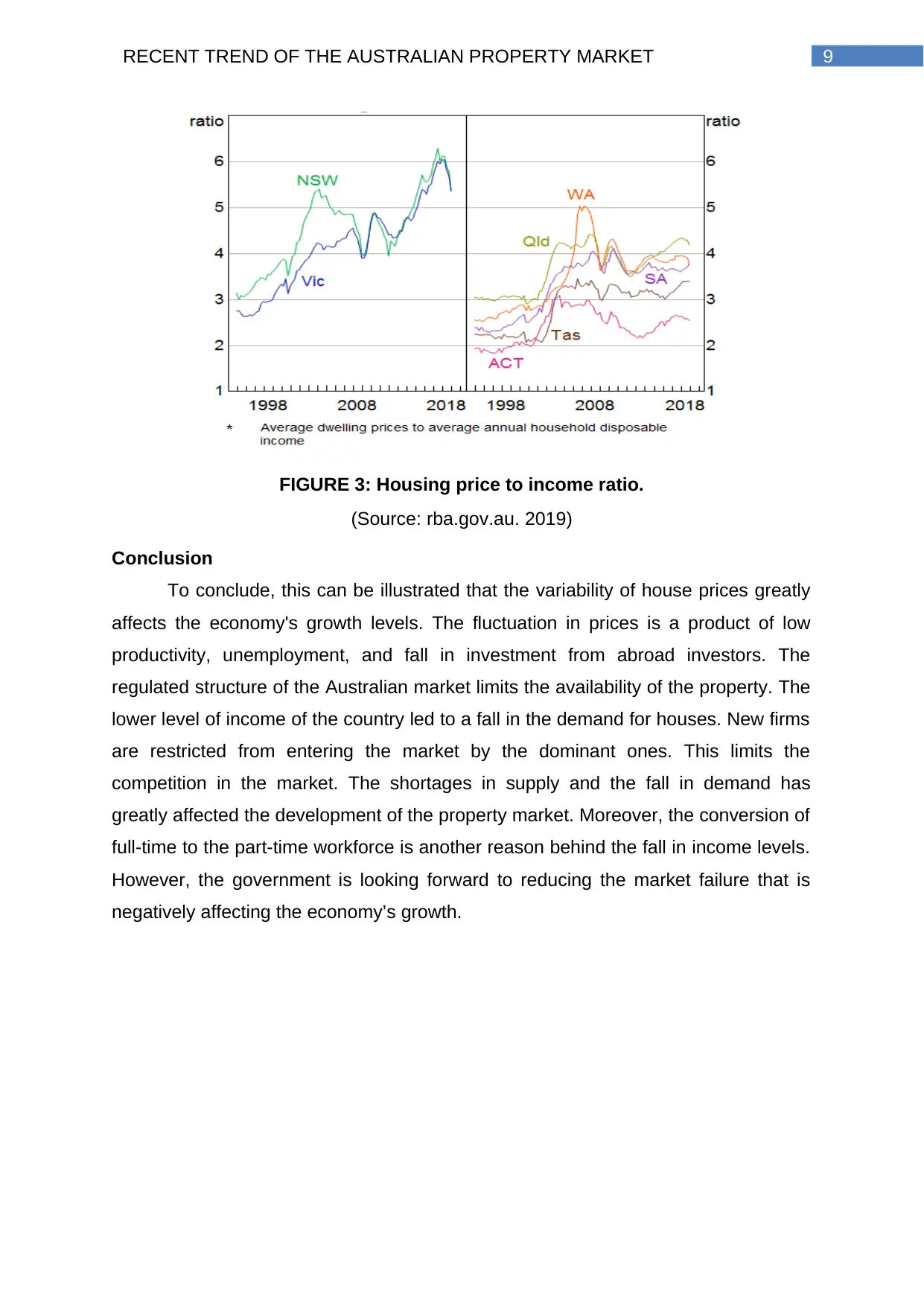
9RECENT TREND OF THE AUSTRALIAN PROPERTY MARKET
FIGURE 3: Housing price to income ratio.
(Source: rba.gov.au. 2019)
Conclusion
To conclude, this can be illustrated that the variability of house prices greatly
affects the economy's growth levels. The fluctuation in prices is a product of low
productivity, unemployment, and fall in investment from abroad investors. The
regulated structure of the Australian market limits the availability of the property. The
lower level of income of the country led to a fall in the demand for houses. New firms
are restricted from entering the market by the dominant ones. This limits the
competition in the market. The shortages in supply and the fall in demand has
greatly affected the development of the property market. Moreover, the conversion of
full-time to the part-time workforce is another reason behind the fall in income levels.
However, the government is looking forward to reducing the market failure that is
negatively affecting the economy’s growth.
FIGURE 3: Housing price to income ratio.
(Source: rba.gov.au. 2019)
Conclusion
To conclude, this can be illustrated that the variability of house prices greatly
affects the economy's growth levels. The fluctuation in prices is a product of low
productivity, unemployment, and fall in investment from abroad investors. The
regulated structure of the Australian market limits the availability of the property. The
lower level of income of the country led to a fall in the demand for houses. New firms
are restricted from entering the market by the dominant ones. This limits the
competition in the market. The shortages in supply and the fall in demand has
greatly affected the development of the property market. Moreover, the conversion of
full-time to the part-time workforce is another reason behind the fall in income levels.
However, the government is looking forward to reducing the market failure that is
negatively affecting the economy’s growth.
Paraphrase This Document
Need a fresh take? Get an instant paraphrase of this document with our AI Paraphraser
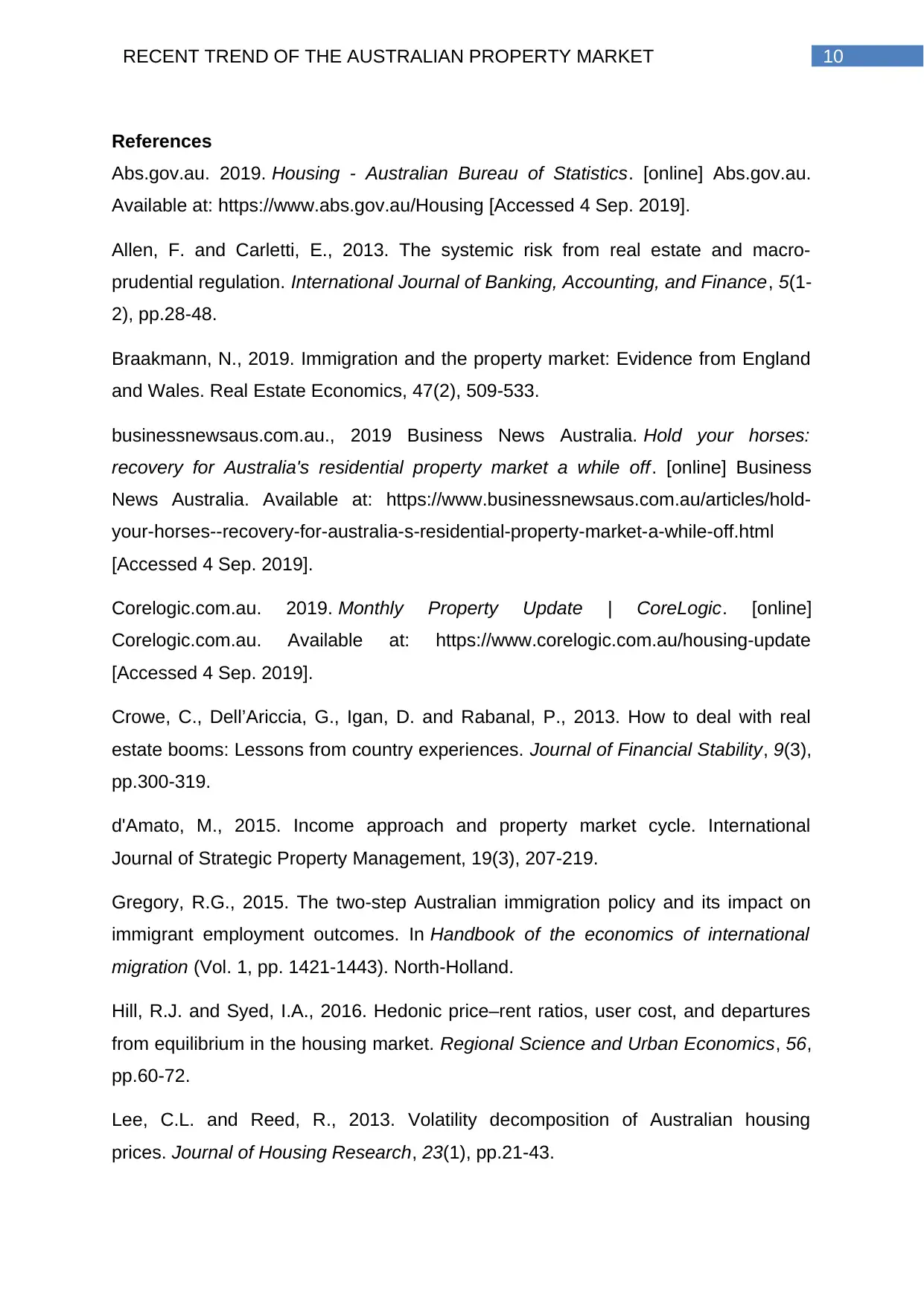
10RECENT TREND OF THE AUSTRALIAN PROPERTY MARKET
References
Abs.gov.au. 2019. Housing - Australian Bureau of Statistics. [online] Abs.gov.au.
Available at: https://www.abs.gov.au/Housing [Accessed 4 Sep. 2019].
Allen, F. and Carletti, E., 2013. The systemic risk from real estate and macro-
prudential regulation. International Journal of Banking, Accounting, and Finance, 5(1-
2), pp.28-48.
Braakmann, N., 2019. Immigration and the property market: Evidence from England
and Wales. Real Estate Economics, 47(2), 509-533.
businessnewsaus.com.au., 2019 Business News Australia. Hold your horses:
recovery for Australia's residential property market a while off. [online] Business
News Australia. Available at: https://www.businessnewsaus.com.au/articles/hold-
your-horses--recovery-for-australia-s-residential-property-market-a-while-off.html
[Accessed 4 Sep. 2019].
Corelogic.com.au. 2019. Monthly Property Update | CoreLogic. [online]
Corelogic.com.au. Available at: https://www.corelogic.com.au/housing-update
[Accessed 4 Sep. 2019].
Crowe, C., Dell’Ariccia, G., Igan, D. and Rabanal, P., 2013. How to deal with real
estate booms: Lessons from country experiences. Journal of Financial Stability, 9(3),
pp.300-319.
d'Amato, M., 2015. Income approach and property market cycle. International
Journal of Strategic Property Management, 19(3), 207-219.
Gregory, R.G., 2015. The two-step Australian immigration policy and its impact on
immigrant employment outcomes. In Handbook of the economics of international
migration (Vol. 1, pp. 1421-1443). North-Holland.
Hill, R.J. and Syed, I.A., 2016. Hedonic price–rent ratios, user cost, and departures
from equilibrium in the housing market. Regional Science and Urban Economics, 56,
pp.60-72.
Lee, C.L. and Reed, R., 2013. Volatility decomposition of Australian housing
prices. Journal of Housing Research, 23(1), pp.21-43.
References
Abs.gov.au. 2019. Housing - Australian Bureau of Statistics. [online] Abs.gov.au.
Available at: https://www.abs.gov.au/Housing [Accessed 4 Sep. 2019].
Allen, F. and Carletti, E., 2013. The systemic risk from real estate and macro-
prudential regulation. International Journal of Banking, Accounting, and Finance, 5(1-
2), pp.28-48.
Braakmann, N., 2019. Immigration and the property market: Evidence from England
and Wales. Real Estate Economics, 47(2), 509-533.
businessnewsaus.com.au., 2019 Business News Australia. Hold your horses:
recovery for Australia's residential property market a while off. [online] Business
News Australia. Available at: https://www.businessnewsaus.com.au/articles/hold-
your-horses--recovery-for-australia-s-residential-property-market-a-while-off.html
[Accessed 4 Sep. 2019].
Corelogic.com.au. 2019. Monthly Property Update | CoreLogic. [online]
Corelogic.com.au. Available at: https://www.corelogic.com.au/housing-update
[Accessed 4 Sep. 2019].
Crowe, C., Dell’Ariccia, G., Igan, D. and Rabanal, P., 2013. How to deal with real
estate booms: Lessons from country experiences. Journal of Financial Stability, 9(3),
pp.300-319.
d'Amato, M., 2015. Income approach and property market cycle. International
Journal of Strategic Property Management, 19(3), 207-219.
Gregory, R.G., 2015. The two-step Australian immigration policy and its impact on
immigrant employment outcomes. In Handbook of the economics of international
migration (Vol. 1, pp. 1421-1443). North-Holland.
Hill, R.J. and Syed, I.A., 2016. Hedonic price–rent ratios, user cost, and departures
from equilibrium in the housing market. Regional Science and Urban Economics, 56,
pp.60-72.
Lee, C.L. and Reed, R., 2013. Volatility decomposition of Australian housing
prices. Journal of Housing Research, 23(1), pp.21-43.
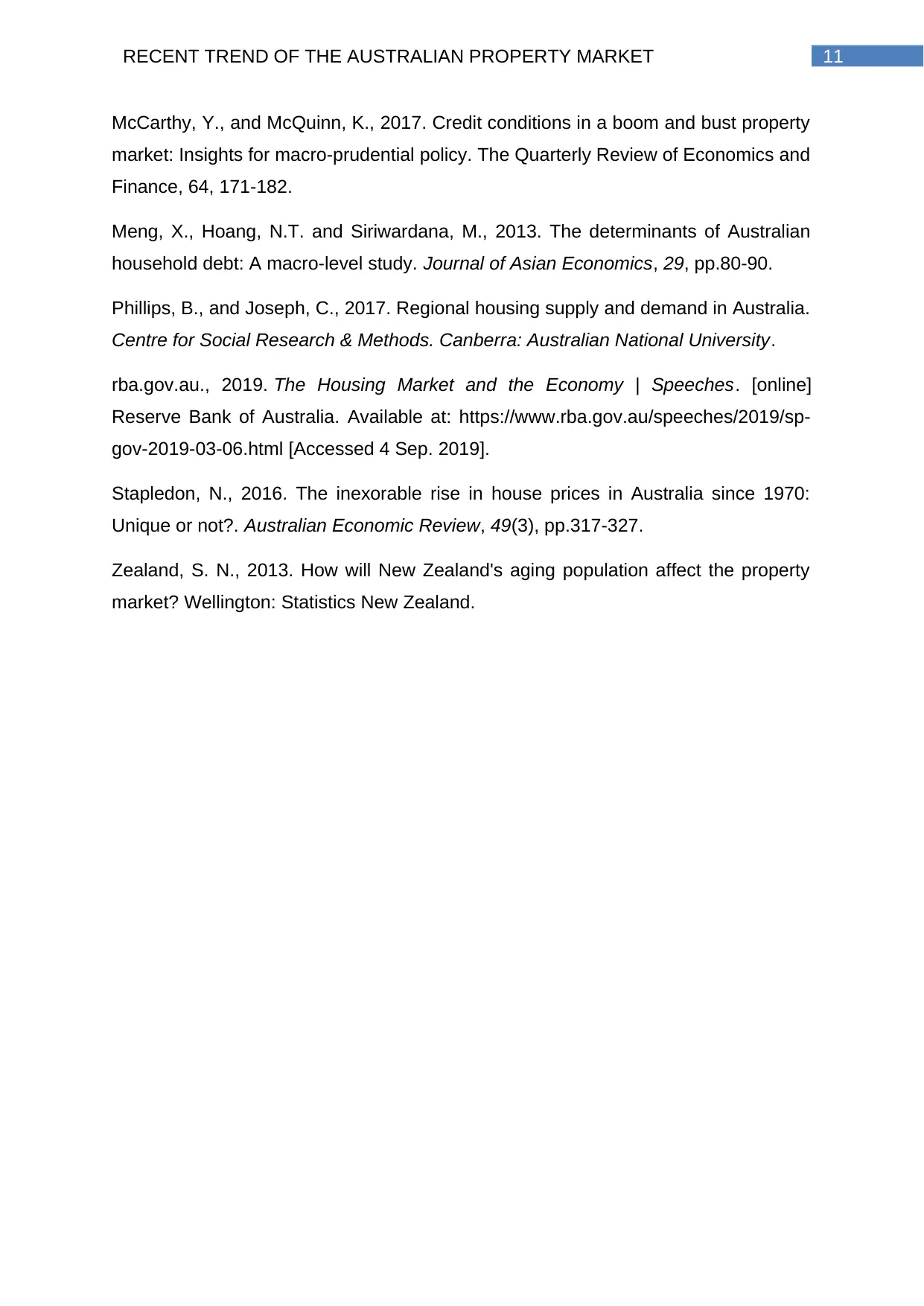
11RECENT TREND OF THE AUSTRALIAN PROPERTY MARKET
McCarthy, Y., and McQuinn, K., 2017. Credit conditions in a boom and bust property
market: Insights for macro-prudential policy. The Quarterly Review of Economics and
Finance, 64, 171-182.
Meng, X., Hoang, N.T. and Siriwardana, M., 2013. The determinants of Australian
household debt: A macro-level study. Journal of Asian Economics, 29, pp.80-90.
Phillips, B., and Joseph, C., 2017. Regional housing supply and demand in Australia.
Centre for Social Research & Methods. Canberra: Australian National University.
rba.gov.au., 2019. The Housing Market and the Economy | Speeches. [online]
Reserve Bank of Australia. Available at: https://www.rba.gov.au/speeches/2019/sp-
gov-2019-03-06.html [Accessed 4 Sep. 2019].
Stapledon, N., 2016. The inexorable rise in house prices in Australia since 1970:
Unique or not?. Australian Economic Review, 49(3), pp.317-327.
Zealand, S. N., 2013. How will New Zealand's aging population affect the property
market? Wellington: Statistics New Zealand.
McCarthy, Y., and McQuinn, K., 2017. Credit conditions in a boom and bust property
market: Insights for macro-prudential policy. The Quarterly Review of Economics and
Finance, 64, 171-182.
Meng, X., Hoang, N.T. and Siriwardana, M., 2013. The determinants of Australian
household debt: A macro-level study. Journal of Asian Economics, 29, pp.80-90.
Phillips, B., and Joseph, C., 2017. Regional housing supply and demand in Australia.
Centre for Social Research & Methods. Canberra: Australian National University.
rba.gov.au., 2019. The Housing Market and the Economy | Speeches. [online]
Reserve Bank of Australia. Available at: https://www.rba.gov.au/speeches/2019/sp-
gov-2019-03-06.html [Accessed 4 Sep. 2019].
Stapledon, N., 2016. The inexorable rise in house prices in Australia since 1970:
Unique or not?. Australian Economic Review, 49(3), pp.317-327.
Zealand, S. N., 2013. How will New Zealand's aging population affect the property
market? Wellington: Statistics New Zealand.
⊘ This is a preview!⊘
Do you want full access?
Subscribe today to unlock all pages.

Trusted by 1+ million students worldwide
1 out of 12
Related Documents
Your All-in-One AI-Powered Toolkit for Academic Success.
+13062052269
info@desklib.com
Available 24*7 on WhatsApp / Email
![[object Object]](/_next/static/media/star-bottom.7253800d.svg)
Unlock your academic potential
Copyright © 2020–2025 A2Z Services. All Rights Reserved. Developed and managed by ZUCOL.





